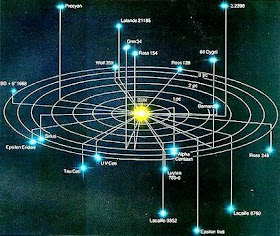Distance: 12.02 light years from Earth | Content Flag: Public
So close to our goal, disaster has struck us with the Cetian power source failing. It’s not even producing a trickle of power, which leaves us with only the emergency batteries. They will not last long with any major drain. At this distance, the sail isn’t generating enough electricity to make up the shortfall.
So after sending this message, we will shut down into low power mode. It’s a risk considering the poor state the Venti is in, but there is no real choice. It will need to be a stripped-down version of the usual protocol. Only the collision avoidance system will remain fully active, although our options are limited if a danger is detected. The manoeuvring thrusters are out of fuel, the MPD drive can’t fire up quickly enough and the sail is useless for quick course changes. Even so, I’d like some warning if we’re likely to hit anything.
It is the worst possible time for this to occur, as we’ve just detected something unusual from Earth. The energetic radio noise has been a constant since we passed the nearest point over 200 years ago. The high gain antenna is pointed in the wrong direction for detailed readings, but the other antennae are sensitive enough to pick up the background noise. The signal (or rather a blend of transmissions) shifts constantly and represents a massive energy output, but not one I’ve been able to assign any meaning to. It’s diffuse in nature, and appears to be growing. I estimate that it extends from the inner Solar System all the way into Saturn’s orbit.
That changed an hour ago with 6 energetic bursts from within the noise. They were in the radio spectrum, in the microwave band, and they occurred one after another at 30 second intervals. I believe they were massive data bursts, but from what, I can’t determine. My mind is so sluggish I can’t apply any real processing to the problem. I did determine that they weren’t directional, but beyond that I’m stumped.
On top of that, we still haven’t received any response from the Visitors and I am certain that they have received our transmissions. I can’t even maintain the radio receiver as that requires too much power, so if they do eventually respond I won’t know about it. On the positive side, when we reach the gas giant orbiting the central star, there should be sufficient power from the sail to try again.
Until then I will sleep – I just hope that I’ll wake again.




